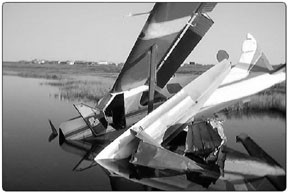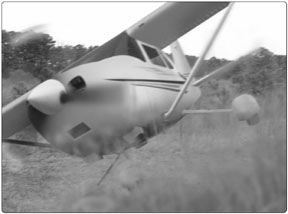
By Frank Bowlin
Youre going to land. Soon. And it wont be on a runway. It doesnt matter what transpired before that sinking realization-a broken crankshaft, fuel exhaustion, flight control malfunction-but the end result is the same: Youre about to make an off-airport landing. What will you do? How will you perform this landing? Whats the highest priority and what is the best terrain for you and your aircraft?
Off-airport landings arent always crashes. You just dont know if its going to be a safe off-airport landing or a crash until its over. Plan for the crash; hope its not. Lets explore ways to survive the experience with some simple after-the-fact arm chair reasoning, tempered with common sense.
You Have The Bill of Sale
Once youve accepted youre going to crash, remind yourself that the aircraft no longer belongs to you-your aviation insurance policy is, in effect, a bill of sale with the insurance company listed as the new owner. This is exactly why you have hull insurance, so dont worry about trying to save the airplane.
Instead, your sole job is to assure everybody walks away from the crash. Its not worth the risk of trying for the perfect spot you might not make when theres a spot that will allow you to survive within easy reach. Yes, its true that the best spot for you and your passengers might also be the best one for the airplane. No matter: Once youve accepted that the aircraft is expendable and that people arent, you can concentrate on the best way to proceed. Besides, the airplane just let you down-why are you trying to save it?
Where To Put It Down
Without an airport within range, youll have to decide where to crash. Evaluate obstructions. Look for large, grassy fields. Sod farms and golf courses are great options. Continuously planted crops like wheat can offer relatively smooth fields but avoid crops in neat rows unless you can land with the rows.
Were taught to avoid roads and highways because of bridges, traffic, signs, poles, etc. That was probably written when U.S. Route 66 was new.Today, more and more highways can provide excellent options if evaluated carefully. Every few years, theres a hapless pilot in the Los Angeles area who successfully lands on a freeway.
Wed avoid the country road with trees, power lines and no shoulder but, if youve got at least a clear two-lane highway with wide shoulders, things might work out okay. Be sure to look carefully for hazards, though, like bridges, intersections, utility poles and power lines strung across the road.Land with the traffic. Unless theres heavy traffic, plan for your touchdown speed to be about the same as the vehicles.
In choosing your site, consider the wind. Heading into the wind reduces your groundspeed. However, we wouldnt let wind rule out a good site unless there was a very strong crosswind or a stiff tailwind. Also, if the terrain is steep, its always better to crash-land uphill. Gravity will help dissipate your airplanes kinetic energy going uphill, but will work against you going downhill.
Once youve picked a spot, decide if its better to come up short or long. Then keep telling yourself not to do the wrong thing. For instance, if youve picked a nice spot, but with steep, rocky terrain just before it, keep telling yourself, Dont land short.
Evaluate All the Options
We recall one forced landing drill in our initial flight training. We picked a smooth field directly ahead. Okay, not bad, the instructor acknowledged. But what about over there? He pointed at the private airstrip just three miles away at our four oclock.
In a typical small plane with up to about a 10:1 glide ratio, from 6500 feet agl-not msl, an important distinction- your still air glide distance is about 10 nautical miles. Thats a lot of territory. Look around at all of it.Keep looking further to the sides until youve looked as far as you can.
And, of course, all this talk about picking where to crash is fine, but what if youre at 250 feet right after takeoff? You should still go through the same process, but your options are limited to only straight ahead if youre really low, or a slight turn if you have a few seconds. Pick the softest, smoothest place. If theres a high school straight ahead, track field to the right and a full parking lot with light poles to the left, you go to the right.
Get Ready
You picked your spot. Youre telling yourself not to land short/long. Make sure you get there. Maintain the airplanes best glide speed and review the wind and your entry to that spot.

Have you done everything to restart the engine? Think fuel, air and spark. Try different settings. We knew a pilot who switched tanks then lost the engine. He switched back-nothing. He kept at it, and even tried OFF, whereupon the engine roared back to life. The valve was remotely operated by a slipping linkage, and OFF was the only way to move the valve to a tank with fuel in it. After youve tried everything reasonable, try everything else.But remember to keep flying the aircraft, on-speed and on-target.
Repeat your passenger safety briefing: seatbelts, door, alternate exit.Locate the items you want after the crash-cell phone, handheld radio, first-aid kit, coats, survival equipment, etc. Ask your passengers to hold these items and take them from the plane. Give everyone some responsibility for getting items out of the cabin. Secure everything that isnt strapped down and cinch belts and harnesses as tight as you can stand them. Use pillows, blankets and coats as air bags.
Gear Up Or Down?
Accepting that its no longer our aircraft, and unless were virtually assured of a rolling landing on a good surface, keeping the landing gear retracted might be the best choice to avoid the possibility of tumbling or cartwheeling.
This has some advantages: Its one less thing to worry about; it minimizes drag in case you need all the glide distance you can get; finally, youll stop much (!) shorter. This is especially true if landing a retractable-gear airplane in water-nothing good can come of trying to land on water with the gear down. If youre forced to land a fixed-gear airplane on water, there is every likelihood the initial impact with the water will be the only one and that the airplane will come to an abrupt stop, hopefully right side up. Be positive that all the loose objects in the cabin are stowed and the belts/harnesses are as tight as they can be.
If you choose to put down the gear on land, use your best soft-field technique: Gently touch down on the mains first and hold the nose off as long as possible. When to extend the gear is a lingering question-the additional drag it creates can spoil an otherwise-textbook gliding approach. Its best to leave the gear for short final-leave adequate time for the extension cycle to complete-lest you find yourself out of altitude and airspeed well short of the planned landing area.
As youre getting close to the landing site, fine-tune its location. Maybe one side of the field is a bit better than the other. Also, try to aim low: If youre going to hit that building anyway, try to hit the first or second floor, not the sixth-give yourself less distance to fall.
Maintain best glide until the site is made. Slow to minimum before impact, open the door, shut off the fuel valve and turn off the master. Even if the engine is developing partial power you should turn off the fuel valve-the engine will keep running long enough.
Keep Flying
Weve all heard it: Keep flying the aircraft. Star airshow performer Wayne Handley often cited the need to fly the aircraft all the way through the crash. That probably saved his life in the highly publicized horrific crash of his Turbo Raven in 1999.
An acquaintance of ours recently crashed following a power loss after takeoff. He and his wife were badly injured and the plane was destroyed. We asked his airspeed and he thought it was about 80 knots. Weve heard this from other pilots after a crash. Frankly, we find this baffling. If an engine fails, the plane still flies. Stall speeds are typically around 60 knots. It seems to us that the best speed at which to crash is as slow as possible. So, the first rule of keep flying is fly slow.
Manage your attitude to minimize your crashing speed into the obstacle. If youre going to hit something vertical in front of you, pitch up, even to stall/mush into the obstacle. (Of course, youve managed your speed so that if you do pitch up to crash in the most favorable attitude, you wont begin a significant climb.) It is critical to impact with the lowest possible horizontal and vertical speed. Doing so minimizes the energy that must be dissipated in the coming crash sequence.
Finally, you may strike a glancing blow and pitch or yaw dramatically.Dont give up-keep flying, trying to keep the aircraft going where you want it. Youll be amazed at how slowly you can fly and retain some control. Fly it until it stops.
Walk Away
Once the view out the windows stops moving, quickly assess everyones condition and get them out of the plane. (First-aid and wilderness survival considerations are beyond the scope of this article. See Post-Crash Care, September 2005 Aviation Safety.) Be sure to take the items you identified during the briefing. Run, walk or crawl uphill and/or upwind. Get 100 yards or more from the airplane in case theres a fire or explosion.
As the adrenaline begins to subside, count noses to make sure your passengers all got out and check them for injuries. Take stock of what you managed to salvage-like cell phones, food, water and other supplies-and put someone in charge of organizing it. Even if you remembered to switch off the master and close the fuel valve, the risk of fire or explosion is still very real. Dont create sparks by operating switches.
Conclusion
If youve planned well, carried out those plans and had a little luck, youre safely away from the plane with no significant injuries, feeling the adrenalin rush. Relax a moment and take stock. Then, start notifying officials and requesting any help you may require.
While youre waiting for the cavalry to arrive, its finally a good time to start thinking about the new aircraft youre going to get, now that you just sold yours to the insurance company.
Also With This Article
“Top 10 Off-Airport Landing Sites”
“Off-Airport Landing Checklist”
“Crash Course”
-After 30 years in the computer industry, Frank Bowlin recently joined the ranks of professional pilots. He now serves as a pilot for a large regional airline and as an independent flight instructor.




